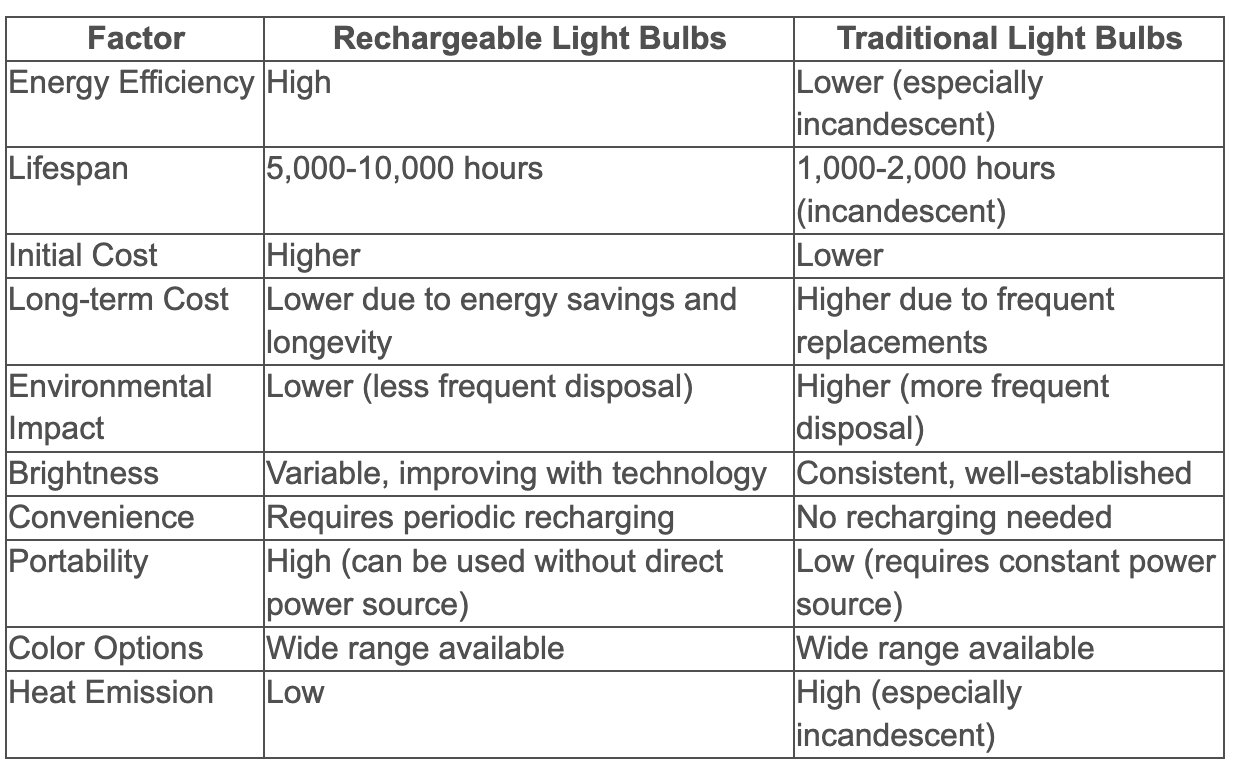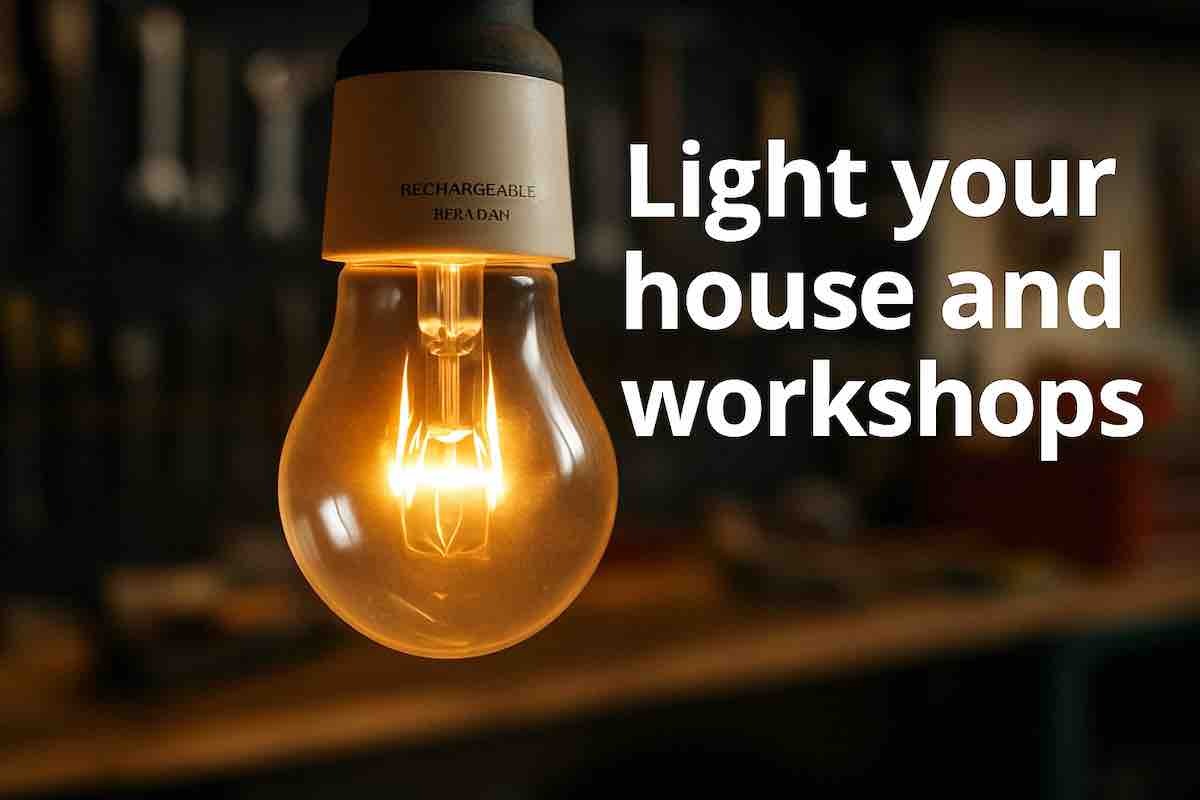Exploring the Pros and Cons of Rechargeable Light Bulbs
Exploring the Pros and Cons of Rechargeable Light Bulbs
This article explores the prons and cons of rechargeable light bulbs and answers, "What are rechargeable light bulbs?" It also highlights the advantages and disadvantages of using rechargeable light bulbs, including their lifespan, brightness, and cost-effectiveness.
Rechargeable light bulbs are becoming increasingly popular as people seek more energy-efficient and cost-effective lighting options. In this article, we will discuss what rechargeable light bulbs are and how they work.
Key Takeaway
Rechargeable light bulbs offer a blend of innovation, convenience, and eco-friendliness in home lighting. While they present significant advantages such as energy efficiency, cost savings over time, and reduced environmental impact, they also come with considerations like initial higher costs and potential limitations in brightness. The decision to switch to rechargeable bulbs should be based on individual needs, usage patterns, and long-term cost-benefit analysis. As technology advances, these bulbs are becoming increasingly viable alternatives to traditional lighting, especially for those prioritizing sustainability and energy conservation in their homes or businesses.
What are Rechargeable Light Bulbs?
Rechargeable light bulbs are a type of lighting option that allows you to recharge the bulb instead of replacing it when it burns out. These bulbs contain a rechargeable battery that can be charged using a charging station or a USB cable. Several types of rechargeable light bulbs are available in the market, including LED, fluorescent, and incandescent bulbs.
 Buy this Portable Rechargeable worklight from Amazon
Buy this Portable Rechargeable worklight from Amazon
Definition and Characteristics
Rechargeable light bulbs are light bulbs that can be recharged, which means that they don't need to be replaced frequently. They come with a rechargeable battery that can store energy and power the bulb when turned on. These bulbs can be used in different settings, including homes, offices, and outdoor environments.
B. How They Work
Rechargeable light bulbs store energy in their rechargeable batteries. When the bulb is turned on, the battery provides power to the bulb, illuminating the room. The battery can be recharged using a charging station or a USB cable, which makes these bulbs convenient and easy to use.
Products to Explore Neporal MagicGlow Rechargeable Light Bulbs with Remote, 3 Colors Shift + Stepless Dimmable Battery Light Bulbs, USB Rechargeable, A19, Up to 24 Hours
Things to Consider Before Buying:
- Lumen Output: Crucial for determining brightness.
- Battery Capacity/Charging Time: How long does it last, and how long does it take to recharge?
- Color Temperature Range: Are the three color temperatures suitable for your needs?
- Dimming Range: How finely can you adjust the brightness?
- Price: Compare with other rechargeable and standard bulbs.
- Reviews: Look for user feedback on battery life, reliability, and performance.
The Neporal MagicGlow bulbs are a practical choice for power outages, cordless lighting, and adjustable ambiance. The three color temperatures and dimming are useful features. However, carefully consider the lumen output, battery life expectations, and price before purchasing. If you need more color options (RGB) or exceptionally long runtimes, other bulbs might be a better fit. As always, "best" is subjective and depends on your specific lighting requirements.
Check this product out: Neporal MagicGlow Rechargeable Light Bulbs with Remote, 3 Colors Shift + Stepless Dimmable Battery Light Bulbs, USB Rechargeable, A19, Up to 24 Hours
Things to Consider Before Buying:
- Lumen Output: How bright do you need the light to be?
- Battery Capacity: How long do you need the light to last on a single charge?
- Charging Time: How quickly do you need the light to recharge?
- Color Temperature: If you don't need RGB, consider bulbs with a specific color temperature (e.g., warm white, cool white).
- Price: Balance cost with features and benefits.
- Reviews: Read reviews from other users to get an idea of the product's reliability and performance.
In conclusion: The Neporal MAGIXPRO bulbs offer a compelling set of features, especially for power outages, cordless lighting, and mood lighting. They are a good option to consider if those use cases are important to you. However, they are not necessarily "the best" for everyone, as cost, brightness, and individual needs play a significant role in determining the ideal lighting solution. Carefully weigh the pros and cons and compare them to other options before making a purchase.
Check this out too:
DanForce Camouflaged Headlamp Ultra Bright USB Rechargeable Head lamp. Tactical Head Flashlight Designed Especially for Hunting & Fishing. LED Headlamps CREE 1080 Lumens Headlight with Red Light
Conquer the darkness on your next hunting or fishing expedition with the DanForce Camouflaged Headlamp. Engineered specifically for outdoor enthusiasts, this tactical head flashlight delivers an impressive 1080 lumens of ultra-bright white light powered by a reliable CREE LED. Its stealthy camouflage pattern blends into natural environments, while the integrated red light mode preserves night vision, crucial for tracking game or managing tackle undetected. Built tough for rugged conditions and conveniently USB rechargeable, this headlamp ensures you have dependable, hands-free illumination exactly when and where you need it most.
C. Types of Rechargeable Light Bulbs:
Different rechargeable light bulbs are available in the market, including LED, fluorescent, and incandescent bulbs. LED bulbs are the most popular rechargeable light bulbs as they are energy-efficient and have a longer lifespan compared to other bulbs. Fluorescent bulbs are also energy-efficient and produce less heat, making them a good option for indoor use. Incandescent bulbs are less popular as they consume more energy and have a shorter lifespan than other bulbs.
Rechargeable light bulbs are an innovative option that provides energy efficiency and convenience. With different rechargeable bulbs, you can choose the one that best suits your needs and preferences.
Advantages of Using Rechargeable Light Bulbs
Rechargeable light bulbs have become a popular alternative to traditional lighting options due to their energy efficiency and convenience. While rechargeable light bulbs have advantages, they also have some drawbacks worth considering.
Pros of Using Rechargeable Light Bulbs
A. Energy Efficiency and Cost Savings Rechargeable light bulbs are more energy-efficient than traditional ones. They use less energy to produce the same amount of light, which can help reduce your electricity bill. Additionally, rechargeable light bulbs don't need to be replaced as frequently as traditional bulbs, so you'll save money in the long run.
B. Environmental Friendliness: Rechargeable light bulbs are also more environmentally friendly than traditional bulbs. They produce less waste because they don't need to be replaced as frequently. Additionally, rechargeable light bulbs are often made with materials that can be recycled, which means that they have a smaller environmental footprint.
C. Durability and Longevity: Rechargeable light bulbs are more durable and last longer than traditional ones. They can withstand more wear and tear and are less likely to break. Additionally, rechargeable light bulbs have a longer lifespan, so you won't need to replace them as frequently.
D. Portability and Flexibility: Rechargeable light bulbs are also more portable and flexible than traditional bulbs. They can be used in different settings, including outdoor environments where there may not be access to electricity. Additionally, rechargeable light bulbs are often designed to be portable, which means that they can be easily moved around as needed and thereby increasing productivity.
Disadvantages of Using Rechargeable Light Bulbs
A. Limited Battery Life and Recharge Cycle: One of the most significant drawbacks of rechargeable light bulbs is their limited battery life and recharge cycle. They need to be recharged after a certain amount of time, which means there may be better lighting options that need to be on for long periods. Additionally, rechargeable light bulbs may hold their charge less over time, so their battery life may decrease as they age.
B. Lower Brightness Levels Compared to Traditional Lighting Options: Rechargeable light bulbs may not be as bright as traditional ones. This can make them less effective for lighting areas that require a lot of light, such as a workspace or a kitchen. Additionally, rechargeable light bulbs may only be able to provide a different level of brightness consistently over time.
C. Initial Investment and Cost: Rechargeable light bulbs have a higher upfront cost than traditional ones. This can be a significant barrier for people switching to rechargeable bulbs. However, it's essential to consider the long-term cost savings and environmental benefits when making this investment. Rechargeable light bulbs have several advantages over traditional lighting options, including energy efficiency, environmental friendliness, durability, and flexibility. However, they also have some drawbacks, including limited battery life and recharge cycles, lower brightness levels, and higher initial costs. Considering these factors is essential when choosing a lighting option that best suits your needs.
Lifespan and Brightness
Rechargeable light bulbs are becoming increasingly popular due to their energy efficiency, cost savings, and environmental friendliness. However, they have drawbacks, including limited battery life and lower brightness levels than traditional lighting options. In this part of the article, we will explore the lifespan and brightness of rechargeable light bulbs, their cost-effectiveness, and how to choose the right ones for your needs.
Lifespan and Brightness of Rechargeable Light Bulbs
A. Factors that affect lifespan and brightness: The lifespan and brightness of rechargeable light bulbs depend on several factors, such as the quality of the battery, the charging and discharging cycle, and the usage. High-quality rechargeable light bulbs with advanced battery technology can last up to 10,000 hours, much longer than traditional ones.
B. Tips for prolonging lifespan and maintaining brightness: These simple tips is to extend the lifespan and keep the shine of rechargeable light bulbs. Avoid overcharging the battery, do not expose the light bulb to extreme temperatures, and use the correct charger. Additionally, cleaning the light bulb regularly is essential to prevent dust and dirt buildup, which can affect its brightness.
Cost-effectiveness of Rechargeable Light Bulbs
A. Comparison of upfront cost vs. long-term cost savings The upfront cost of rechargeable light bulbs can be higher than traditional light bulbs, but they offer long-term cost savings. Since rechargeable light bulbs last longer and use less energy, they can save you money on replacement costs and electricity bills.
B. Factors that affect cost-effectiveness The cost-effectiveness of rechargeable light bulbs depends on various factors, such as the cost of electricity, the frequency of usage, and the lifespan of the light bulb.
C. How to determine if rechargeable light bulbs are cost-effective for you: To examine if rechargeable light bulbs are cost-effective for you, calculate the total cost of ownership, including the initial cost of the bulb, the cost of electricity, and the replacement costs. If the total price is lower than that of traditional light bulbs, rechargeable light bulbs are cost-effective.
Rechargeable vs Traditional Light Bulbs: A Comprehensive Comparison

This comparison chart highlights the key differences between rechargeable and traditional light bulbs, helping consumers make informed decisions based on their specific needs and preferences.
Worksight LED Lights to Consider
Trending product Illuminate your workspace
Illuminate your workspace effectively with the powerful HYCHIKA 50W LED Work Light. 1 This portable flood light boasts an impressive 5500 lumens of bright, 5000K daylight illumination and comes with a convenient stand. 1 Its IP65 waterproof rating makes it durable for both outdoor and indoor jobs, including car repairs or construction sites. 1 Grab it now at a special promotional price of $24.64 (15% off the original $28.99)
Choosing the Right Rechargeable Light Bulbs
A. Consider the brightness level and color temperature. Choose a rechargeable light bulb with a brightness level and color temperature that suits your needs.
B. Determine the battery life and recharge cycle: Check the rechargeable light bulb's battery life and recharge cycle before purchasing it. Look for a bulb with longer battery life and a shorter recharge cycle.
C. Look for additional features, such as waterproofing or dimming capabilities: Some rechargeable light bulbs have different features, such as waterproofing or dimming capabilities. Consider these features when choosing a rechargeable light bulb.
D. Evaluate the initial investment and cost savings over time. Evaluate the initial investment and cost savings over time to determine if a rechargeable light bulb is worth the investment. Consider the lifespan, brightness, and cost-effectiveness to make an informed decision.
Tips for Maximizing Rechargeable Light Bulb Performance
- Optimal Charging Practices:
- Avoid overcharging by unplugging once fully charged
- Use the manufacturer-recommended charger
- Charge at room temperature for best battery health
- Strategic Placement:
- Use in high-traffic areas for maximum energy savings
- Consider ambient temperature when placing outdoors
- Maintenance:
- Clean bulbs regularly to maintain brightness
- Check connections and charging ports for dust or debris
- Usage Patterns:
- Utilize built-in dimming features to extend battery life
- Consider using timers or smart controls for efficient usage
- Storage:
- Store charged bulbs in a cool, dry place when not in use
- For long-term storage, maintain a partial charge (about 50%)
- Mixing with Traditional Lighting:
- Use rechargeable bulbs alongside traditional ones for balanced lighting
- Reserve rechargeable bulbs for areas where their benefits are maximized
- Recycling:
- Familiarize yourself with local recycling options for when the bulb eventually needs replacement
- Never dispose of rechargeable bulbs in regular trash due to their battery content
By following these tips, you can ensure your rechargeable light bulbs perform optimally, last longer, and provide the best value for your investment.
Conclusion
In conclusion, rechargeable light bulbs offer several benefits, including energy efficiency, environmental friendliness, durability, and portability. However, they also have some drawbacks, such as limited battery life and lower brightness levels. It is essential to carefully consider your needs when choosing rechargeable light bulbs, including factors such as brightness level, color temperature, battery life, and additional features like waterproofing or dimming capabilities. While rechargeable light bulbs may require an initial investment, they can provide cost savings over time. With the proper research and consideration, rechargeable light bulbs can be an excellent choice for your lighting needs.
We are dealers of Maxxeon LED Rechargeable lights Contact us or buy from here
Frequently Asked Questions About Rechargeable Light Bulbs
How long do rechargeable light bulbs typically last?
Rechargeable light bulbs can last anywhere from 5,000 to 10,000 hours of use, depending on the quality and technology. This translates to several years of regular use, significantly outlasting traditional incandescent bulbs.
Can rechargeable light bulbs be used in any standard light fixture?
Most rechargeable light bulbs are designed to fit standard light fixtures. However, it's important to check the base type (e.g., E26, E27) and voltage requirements to ensure compatibility with your existing fixtures.
How often do rechargeable light bulbs need to be recharged?
The recharge frequency depends on usage and battery capacity. On average, a fully charged bulb can last 3-8 hours of continuous use. For intermittent use, they might need recharging every few days to a week.
Are rechargeable light bulbs as bright as traditional bulbs?
While early models were less bright, many modern rechargeable LED bulbs can match or exceed the brightness of traditional bulbs. Look for the lumens rating to compare brightness levels.
Can rechargeable light bulbs save money in the long run?
Yes, despite higher upfront costs, rechargeable light bulbs can lead to significant savings over time. They use less energy and need less frequent replacement, reducing both electricity bills and replacement costs over their lifespan.
Future Trends in Rechargeable Light Bulb Technology
As technology continues to evolve, rechargeable light bulbs are set to become even more innovative and efficient. Here are some exciting trends to watch:
- Enhanced Battery Technology:
- Longer-lasting batteries with quicker charging times
- Integration of graphene and other advanced materials for improved performance
- Smart Home Integration:
- Seamless connectivity with home automation systems
- Voice-activated controls and scheduling
- Improved Energy Harvesting:
- Solar-powered recharging capabilities
- Kinetic energy harvesting from ambient vibrations
- Adaptive Lighting:
- Auto-adjusting brightness and color temperature based on time of day and ambient light
- Mood-enhancing lighting patterns for improved well-being
- Eco-Friendly Materials:
- Biodegradable components for reduced environmental impact
- Use of recycled materials in manufacturing
- Enhanced Durability:
- Water and impact-resistant designs for outdoor use
- Self-healing materials to extend bulb lifespan
- Multi-Functional Designs:
- Built-in speakers for audio capabilities
- Emergency lighting features with extended battery backup
These advancements promise to make rechargeable light bulbs even more attractive for consumers seeking efficient, versatile, and environmentally friendly lighting solutions.
Related Articles
How Do Rechargeable Light Bulbs Work?
Top 5 Best Rechargeable LED Work Lights for Mechanics: Brighten Your Workspace
Rechargeable Light Bulbs: Advantages and Limitations
How Long Do Rechargeable Light Bulbs Last
Rechargeable Light Bulbs: Unveiling the Energy Efficiency
Rechargeable LED Lights for Remote Work Sites









